Identifying Slope Hazard Zones in Central Taiwan Using Emerging Hot Spot Analysis and NDVI
Abstract
1. Introduction
2. Materials and Methods
2.1. Study Area
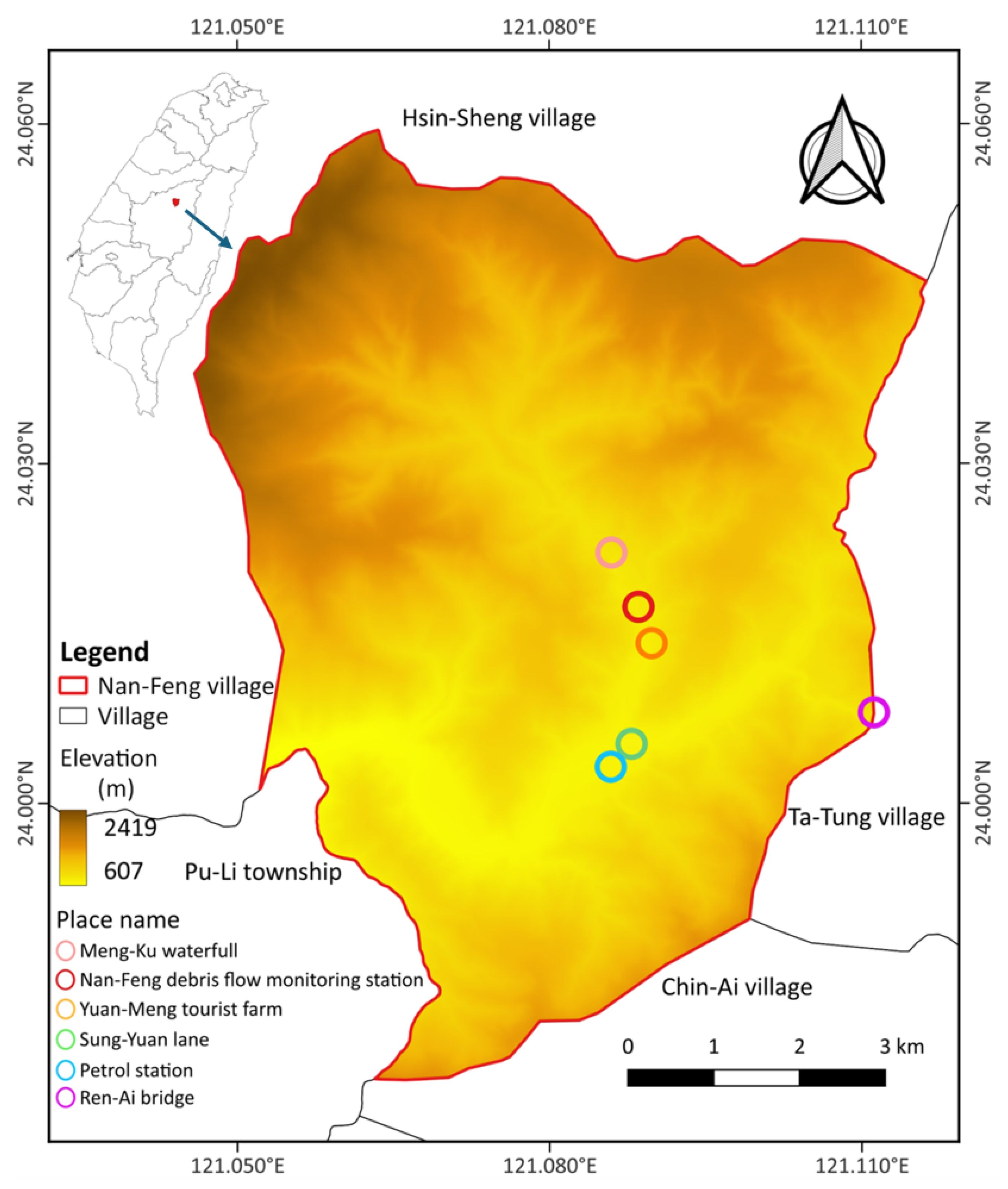
2.2. Data Collection
2.2.1. Satellite Imagery
2.2.2. Land-Use Classification
2.3. Methods
2.3.1. NDVI Calculation and Preprocessing
2.3.2. Trend Analysis Using the MK Trend Test
2.3.3. EHSA with Space-Time Cube
- 1.
- Annual NDVI rasters (2013–2023) from SPOT imagery were resampled and stacked to ensure spatial and temporal consistency. NDVI values, along with their corresponding spatial coordinates and timestamps, were exported.
- 2.
- A space-time cube was constructed using the “Create Space Time Cube by Aggregating Points” tool in ArcGIS Pro. This tool aggregated NDVI values into spatial bins (200 m × 200 m grid cells) and annual temporal slices. The final cube was stored in NetCDF format for multidimensional analysis.
- 3.
- The “Emerging Hot Spot Analysis” tool was then applied to the cube. This tool performed two core statistical operations:
- The Getis-Ord Gi* statistic identified statistically significant clusters of high or low NDVI values (i.e., hot spots and cold spots) for each year.
- The MK trend test detected temporal trends in these clusters, classifying whether hot spot activity was intensifying, diminishing, or remaining stable.
- 4.
- Each spatial location was classified into one of 17 spatiotemporal hot spot categories (Table 2), such as new hot spot, intensifying hot spot, persistent cold spot, oscillating cold spot, and other temporal patterns defined by the Emerging Hot Spot Analysis tool.
3. Results
3.1. Vegetation Trend Analysis via MK Trend Test
3.2. NDVI Emerging Hot Spot Classification
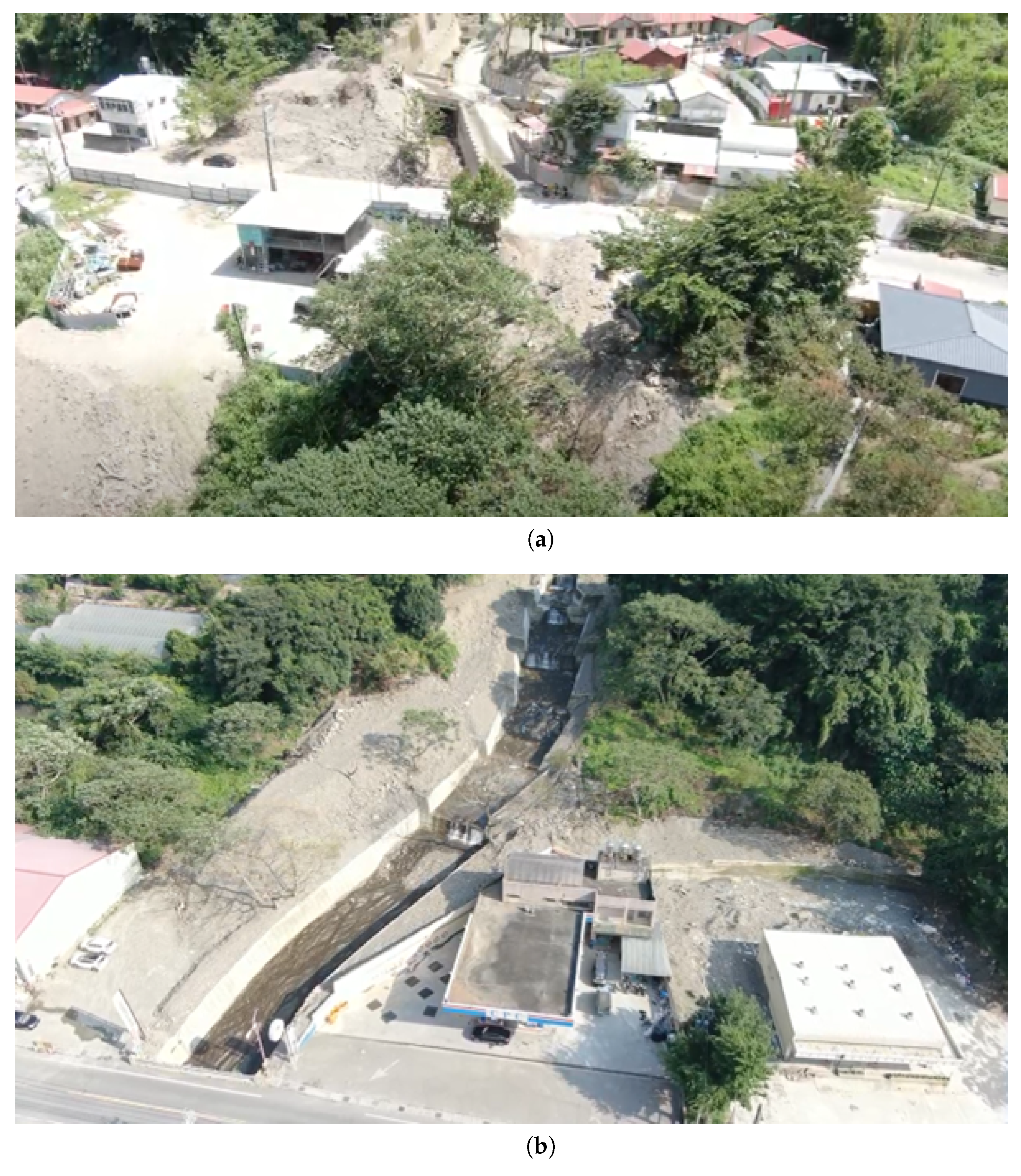
4. Discussion
5. Conclusions
Author Contributions
Funding
Institutional Review Board Statement
Informed Consent Statement
Data Availability Statement
Acknowledgments
Conflicts of Interest
References
- Geertsema, M.; Highland, L.; Vaugeouis, L. Environmental impact of landslides. In Landslides—Disaster Risk Reduction; Springer: Berlin/Heidelberg, Germany, 2009; pp. 589–607. [Google Scholar] [CrossRef]
- Stokes, A.; Douglas, G.B.; Fourcaud, T.; Giadrossich, F.; Gillies, C.; Hubble, T.; Kim, J.H.; Loades, K.W.; Mao, Z.; McIvor, I.R.; et al. Ecological mitigation of hillslope instability: Ten key issues facing researchers and practitioners. Plant Soil 2014, 377, 1–23. [Google Scholar] [CrossRef]
- Gray, D.H.; Sotir, R.B. Biotechnical and Soil Bioengineering Slope Stabilization: A Practical Guide for Erosion Control; John Wiley & Sons: New York, NY, USA, 1996. [Google Scholar]
- Masi, E.B.; Segoni, S.; Tofani, V. Root reinforcement in slope stability models: A review. Geosciences 2021, 11, 212. [Google Scholar] [CrossRef]
- Pettorelli, N. The Normalized Difference Vegetation Index; Oxford University Press: New York, NY, USA, 2013. [Google Scholar] [CrossRef]
- Tian, F.; Fensholt, R.; Verbesselt, J.; Grogan, K.; Horion, S.; Wang, Y. Evaluating temporal consistency of long-term global NDVI datasets for trend analysis. Remote Sens. Environ. 2015, 163, 326–340. [Google Scholar] [CrossRef]
- Xu, B.; Qi, B.; Ji, K.; Liu, Z.; Deng, L.; Jiang, L. Emerging hot spot analysis and the spatial–temporal trends of NDVI in the Jing River Basin of China. Environ. Earth Sci. 2022, 81, 55. [Google Scholar] [CrossRef]
- Hölbling, D.; Friedl, B.; Eisank, C. An object-based approach for semi-automated landslide change detection and attribution of changes to landslide classes in northern Taiwan. Earth Sci. Inform. 2015, 8, 327–335. [Google Scholar] [CrossRef]
- Getis, A.; Ord, J.K. The analysis of spatial association by use of distance statistics. Geogr. Anal. 1992, 24, 189–206. [Google Scholar] [CrossRef]
- Zhong, Z.; Fang, X.; Li, J.; Ma, Q.; Zhou, R.; Hu, Y.; Du, S. Linear and non-linear dynamics of ecosystem services supply, demand, and mismatches across a rapidly urbanizing region. Ecol. Indic. 2024, 158, 111614. [Google Scholar] [CrossRef]
- Cao, Z.; Wu, M.; Wang, D.; Wan, B.; Jiang, H.; Tan, X.; Zhang, Q. Space-time cube uncovers spatiotemporal patterns of basin ecological quality and their relationship with water eutrophication. Sci. Total Environ. 2024, 916, 170195. [Google Scholar] [CrossRef]
- Wang, Y.; He, Y.; Li, J.; Jiang, Y. Evolution simulation and risk analysis of land use functions and structures in ecologically fragile watersheds. Remote Sens. 2022, 14, 5521. [Google Scholar] [CrossRef]
- Liu, Y.; Hou, P.; Wang, P.; Zhu, J.; Zhai, J.; Chen, Y.; Wang, J.; Xie, L. Quantitative analysis about the spatial heterogeneity of water conservation services function using a space–time cube constructed based on ecosystem and soil types. Diversity 2024, 16, 638. [Google Scholar] [CrossRef]
- Yan, D.; Yu, H.; Xiang, Q.; Xu, X. Spatiotemporal patterns of land surface temperature and their response to land cover change: A case study in Sichuan Basin. Egypt. J. Remote Sens. Space Sci. 2023, 26, 1080–1089. [Google Scholar] [CrossRef]
- Ahmadi, H.; Mousavi, B.S.; Argany, M.; Soleimani, M.; Ghanbari, A. Spatiotemporal forecasting of water change trends in Urmia Lake through to 2030, using STC-based models. Hydrol. Sci. J. 2024, 69, 1631–1651. [Google Scholar] [CrossRef]
- Wei, J.; Zhong, Y.; Chen, A.; Tang, H.; Li, D. Space-time cube reveals escalating light pollution in China’s national parks: Impact of boundary geometry and human activities (1992–2021). Environ. Pollut. 2025, 126462. [Google Scholar] [CrossRef] [PubMed]
- Wu, C. Certainty factor analyses and spatiotemporal characteristics of landslide evolution: Case studies in the Chishan river watershed in Taiwan. ISPRS Int. J.-Geo-Inf. 2022, 11, 382. [Google Scholar] [CrossRef]
- Wu, C.-H. Evaluating the landslide stability and vegetation recovery: Case studies in the Tsengwen reservoir watershed in Taiwan. Water 2021, 13, 3479. [Google Scholar] [CrossRef]
- Younas, M.; Khan, S.D.; Qasim, M.; Hamed, Y. Assessing impacts of land subsidence in Victoria County, Texas, using geospatial analysis. Land 2022, 11, 2211. [Google Scholar] [CrossRef]
- Mitasova, H.; Hardin, E.; Starek, M.J.; Harmon, R.S.; Overton, M.F. Landscape Dynamics from LiDAR Data Time Series; International Society for Geomorphometry, 2011; pp. 3–6. Available online: https://geospatial.ncsu.edu/geoforall/pubpdf/Mitasova2011geomorphometry.pdf (accessed on 1 January 2024).
- Melville, T.; Sutherland, M.; Wuddivira, M.N. Assessing trends and predicting the cover management factor in a tropical island state using enhanced vegetation index. SN Appl. Sci. 2020, 2, 1686. [Google Scholar] [CrossRef]
- Memisoglu Baykal, T. GIS-based spatiotemporal analysis of forest fires in Turkey from 2010 to 2020. Trans. GIS 2023, 27, 1289–1317. [Google Scholar] [CrossRef]
- Unnikrishnan, A.; Reddy, C.S. Characterizing distribution of forest fires in Myanmar using earth observations and spatial statistics tool. J. Indian Soc. Remote Sens. 2020, 48, 227–234. [Google Scholar] [CrossRef]
- Wei, J.; Wang, Z.; Han, L.; Shang, J.; Zhao, B. Analysis of spatio-temporal evolution characteristics of drought and its driving factors in Yangtze River Basin based on SPEI. Atmosphere 2022, 13, 1986. [Google Scholar] [CrossRef]
- Pyarali, K.; Peng, J.; Disse, M.; Tuo, Y. Development and application of high resolution SPEI drought dataset for Central Asia. Sci. Data 2022, 9, 172. [Google Scholar] [CrossRef]
- Zhang, H.; Jia, H.; Liu, W.; Wang, J.; Xu, D.; Li, S.; Liu, X. Spatiotemporal information mining for emergency response of urban flood based on social media and remote sensing data. Remote Sens. 2023, 15, 4301. [Google Scholar] [CrossRef]
- He, X.; Zhang, R.; Yuan, X.; Cao, Y.; Zhou, C. The role of planning policy in the evolution of the spatial structure of the Guangzhou metropolitan area in China. Cities 2023, 137, 104284. [Google Scholar] [CrossRef]
- Foșalău, C.-M.; Roșu, L.; Iațu, C.; Dinter, O.-V.; Cristodulo, P.-M. Mapping urban changes through the spatio-temporal analysis of vegetation and built-up areas in Iași, Romania. Sustainability 2025, 17, 11. [Google Scholar] [CrossRef]
- Ghanghermeh, A.; Roshan, G.; Asadi, K.; Attia, S. Spatiotemporal Analysis of Urban Heat Islands and Vegetation Cover Using Emerging Hotspot Analysis in a Humid Subtropical Climate. Atmosphere 2024, 15, 161. [Google Scholar] [CrossRef]
- Ali, A.A.B.; Mitra, C.; Rahaman, S.N. Mapping the heat with spatial trends and emerging temperature hotspots in the Contiguous US (CONUS) counties from 2000 to 2022. Spat. Inf. Res. 2025, 33, 35. [Google Scholar] [CrossRef]
- Xu, S.; Shirowzhan, S.; Sepasgozar, S. Spatiotemporal analysis and GIS-based dashboard development for urban household waste. Smart Sustain. Built Environ. 2025. [Google Scholar] [CrossRef]
- Jiang, Y.; Zhao, S.; Li, H.; Lei, J.; He, L.; Zhu, G.; Bu, J. Spatial-temporal analysis of street patrol cases in Zhengzhou, China, using Getis-Ord Gi* and space-time cube. In Proceedings of the 2023 3rd International Conference on Public Management and Intelligent Society (PMIS 2023), Wuhan, China, 10–12 March 2023; pp. 648–654. [Google Scholar] [CrossRef]
- Guo, M.; Gou, C.; Tan, S.; Feng, C.; Zhao, F. Spatiotemporal characteristics and factors influencing the cycling behavior of shared electric bike use in urban plateau regions. Sustainability 2024, 16, 6570. [Google Scholar] [CrossRef]
- Abdulrazaq, M.A.; Fan, W. A priority based multi-level heterogeneity modelling framework for vulnerable road users. Transp. A Transp. Sci. 2025, 1–34, in press. [Google Scholar] [CrossRef]
- Bilim, A. Identifying unsafe locations for pedestrians in Konya with spatio-temporal analyses. Cities 2025, 156, 105523. [Google Scholar] [CrossRef]
- Sae-Ngow, P.; Kulpanich, N.; Worachairungreung, M.; Sittarachu, N.; Thanakunwutthirot, K.; Hemwan, P. Identification of road crash zones, spatial patterns, and emerging hot spots of road traffic injury severity in Phuket, Thailand. Geoj. Tour. Geosites 2025, 60, 1067–1077. [Google Scholar] [CrossRef]
- Kim, M.; Lee, S. Identification of Emerging Roadkill Hotspots on Korean Expressways Using Space–Time Cubes. Int. J. Environ. Res. Public Health 2023, 20, 4896. [Google Scholar] [CrossRef]
- Kabanda, T.H. Case study: Analysing the progression of artificial lighting in Gauteng Province over a decade using spatio-temporal analysis. Int. J. Cartogr. 2024, 1–17. [Google Scholar] [CrossRef]
- Osman, A.; Owusu, A.B.; Adu-Boahen, K.; Atamey, E. Space-time cube approach in analysing conflicts in Africa. Soc. Sci. Humanit. Open 2023, 8, 100557. [Google Scholar] [CrossRef]
- Xu, R.; Yang, X.; Tian, S. Use of space-time cube model and spatiotemporal hot spot analyses in fisheries—A case study of tuna purse seine. Fishes 2023, 8, 525. [Google Scholar] [CrossRef]
- Fuentes, M.V.B.; Heenkenda, M.K.; Sahota, T.S.; Serrano, L.S. Analyzing winter wheat (Triticum aestivum) growth pattern using high spatial resolution images: A case study at Lakehead University Agriculture Research Station, Thunder Bay, Canada. Crops 2024, 4, 115–133. [Google Scholar] [CrossRef]
- Kong, J.; An, Y.; Shi, X.; Sun, Z.; Wu, L.; Cui, W. Meteorological-Data-Driven Rubber Tree Powdery Mildew Model and Its Application on Spatiotemporal Patterns: A Case Study of Hainan Island. Sustainability 2023, 15, 12119. [Google Scholar] [CrossRef]
- Climate-Data. Climate: Ren’ai Township. Available online: https://en.climate-data.org/asia/taiwan/ren-ai-township/ren-ai-township-12975/ (accessed on 8 August 2025).
- Rouse, J.W.; Haas, R.H.; Schell, J.A.; Deering, D.W. Monitoring Vegetation Systems in the Great Plains with ERTS; NASA Technical Report, NASA-TM-X-62029; Texas A&M University: College Station, TX, USA, 1974. [Google Scholar]
- Mann, H.B. Nonparametric tests against trend. Econometrica 1945, 13, 245–259. [Google Scholar] [CrossRef]
- Kendall, M.G. Rank Correlation Methods, 4th ed.; Charles Griffin: London, UK, 1975. [Google Scholar]
- Hirsch, R.M.; Slack, J.R.; Smith, R.A. Techniques of trend analysis for monthly water quality data. Water Resour. Res. 1982, 18, 107–121. [Google Scholar] [CrossRef]
- Esri. How Emerging Hot Spot Analysis Works. Available online: https://pro.arcgis.com/en/pro-app/latest/tool-reference/space-time-pattern-mining/learnmoreemerging.htm (accessed on 20 June 2025).
- Kang, J.-S.; Lee, S.-H.; Kim, M.-S. Detecting Spatio-Temporal Vegetation Changes Using Emerging Hot Spot Analysis and Mann–Kendall Trend Test: A Case Study of South Korea. Remote Sens. 2020, 12, 475. [Google Scholar] [CrossRef]
- Chakraborty, A. Mountains as vulnerable places: A global synthesis of changing mountain systems in the Anthropocene. GeoJournal 2021, 86, 585–604. [Google Scholar] [CrossRef]
- Shah, N.A.; Shafique, M.; Owen, L.A.; Al-Mulla, Y.; Ullah, Y. Morphometric analysis of debris flow hazard and risk assessment in the mountain terrains of northern Pakistan using remote sensing and field data. Earth Sci. Inform. 2025, 18, 295. [Google Scholar] [CrossRef]
- Hsu, C.-H.; Tsao, T.-C.; Huang, C.-M.; Lee, C.-F.; Lee, Y.-T. Using remote sensing techniques to identify the landslide hazard prone sections along the south link railway in Taiwan. Procedia Eng. 2016, 143, 708–716. [Google Scholar] [CrossRef]
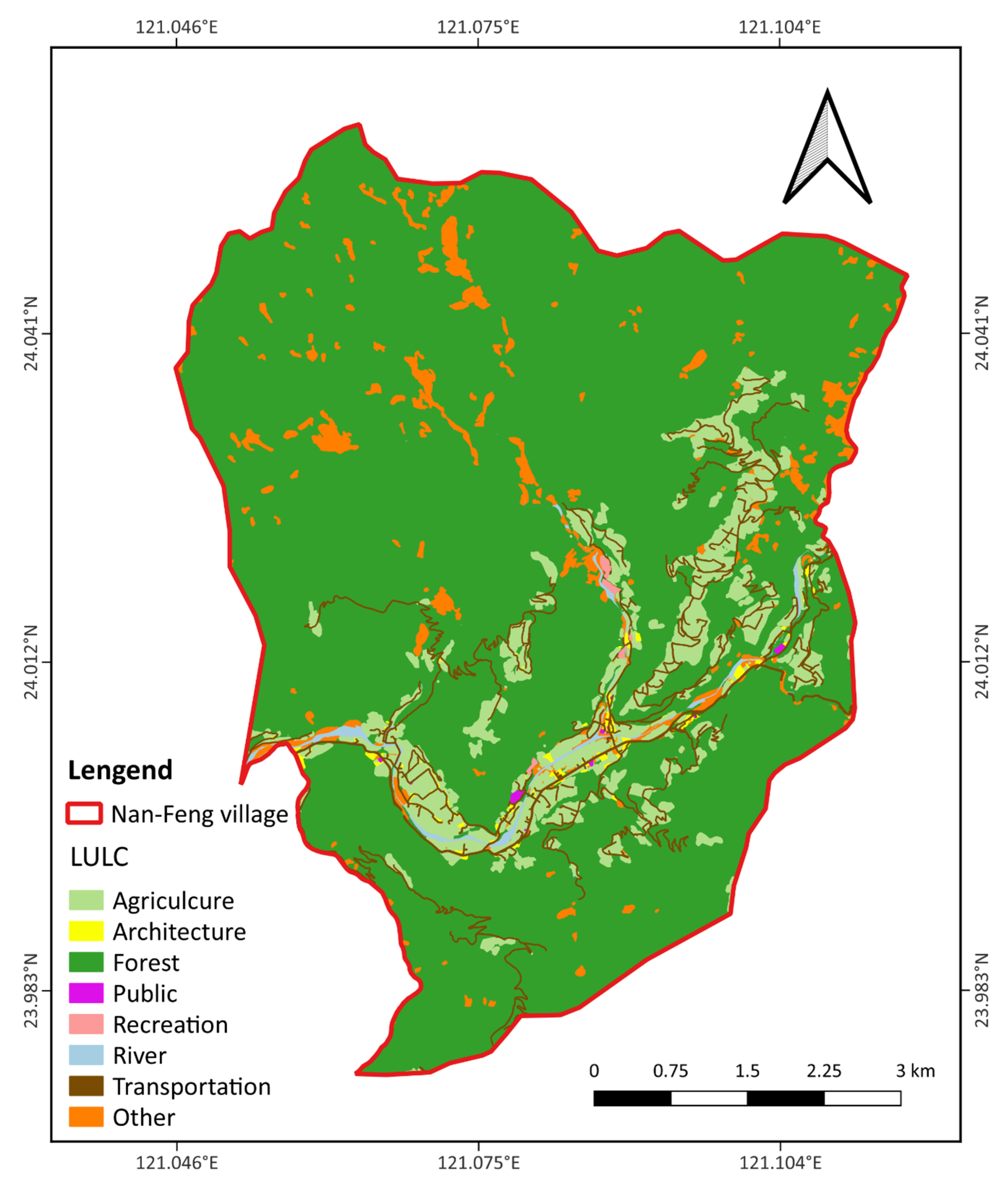
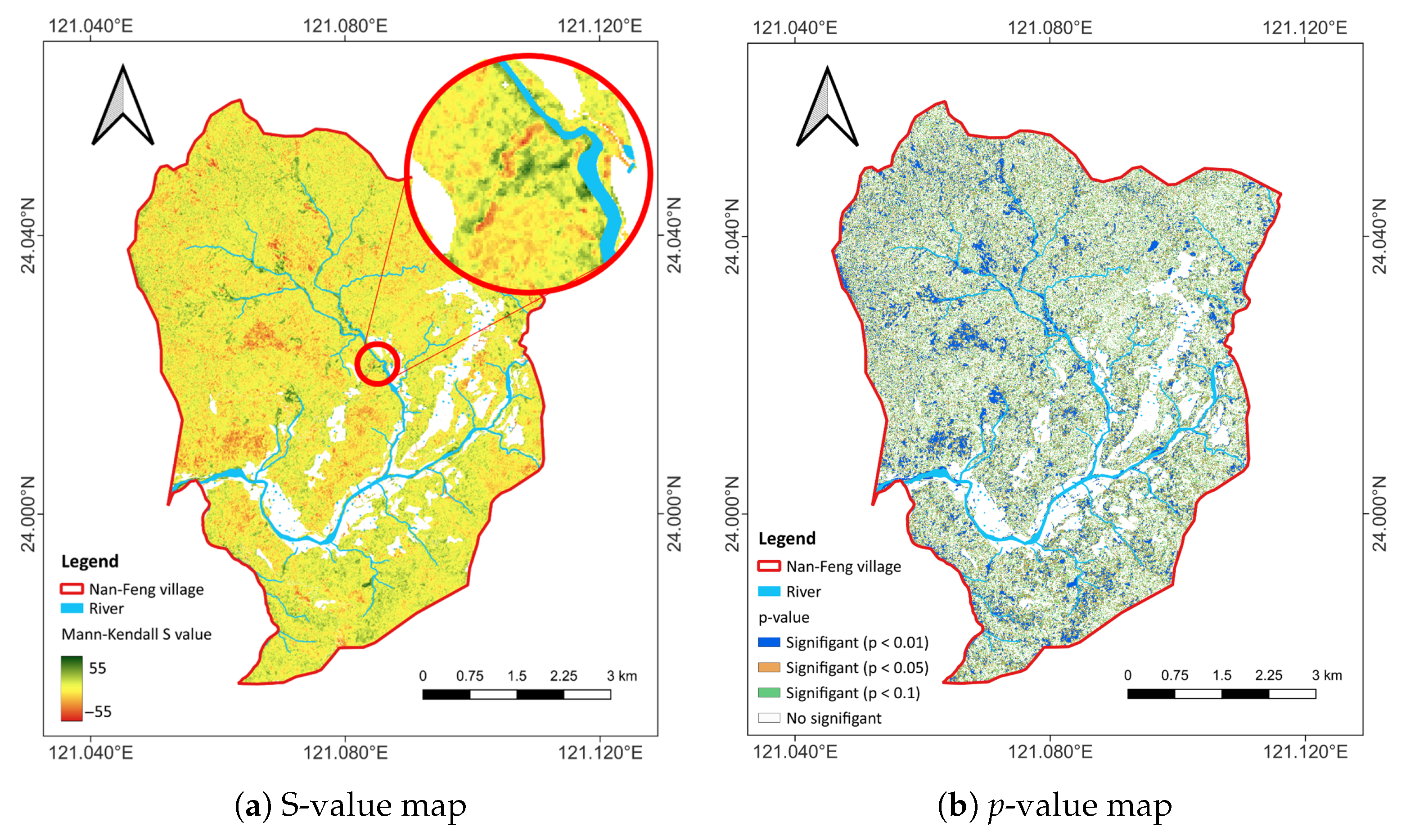
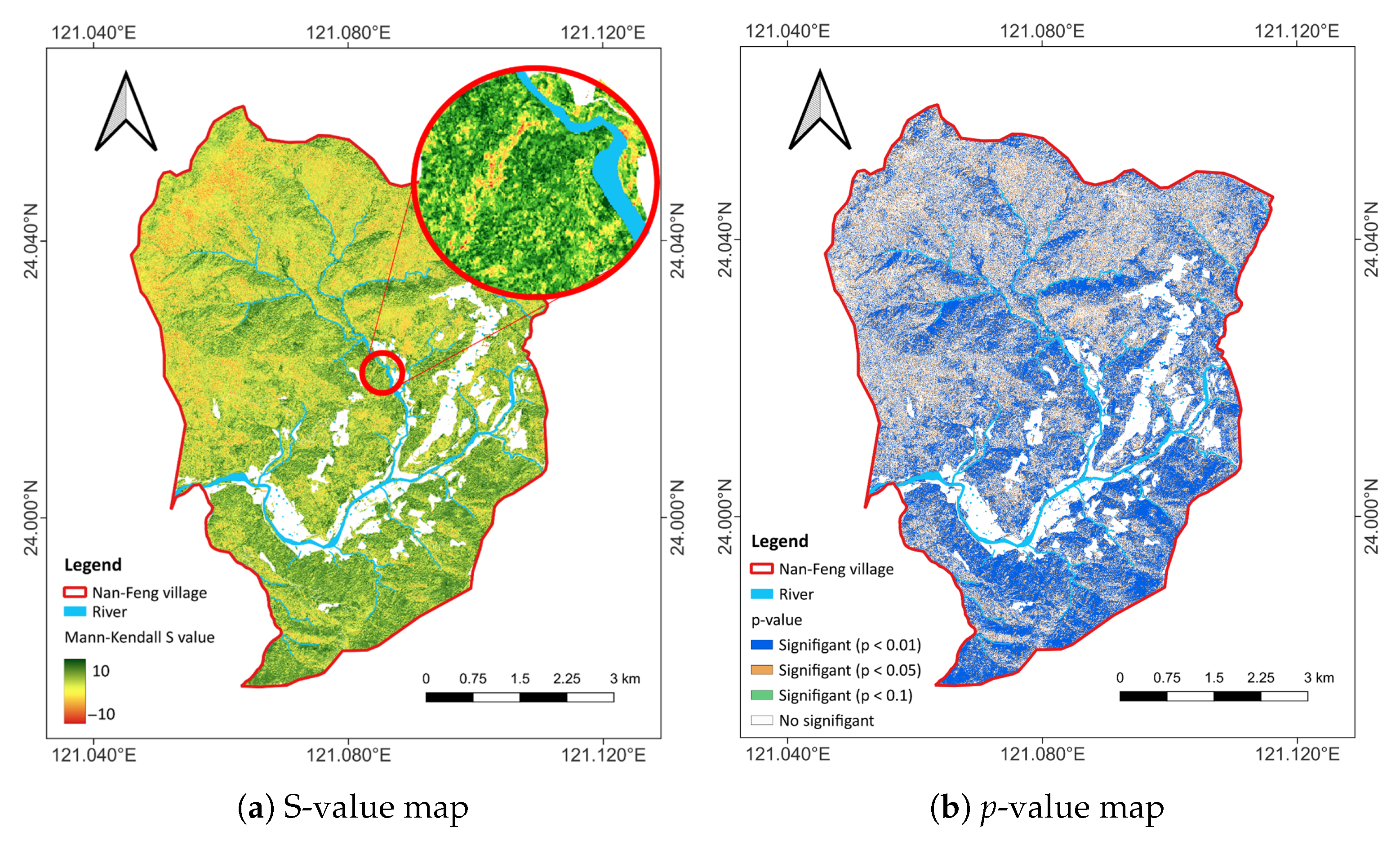
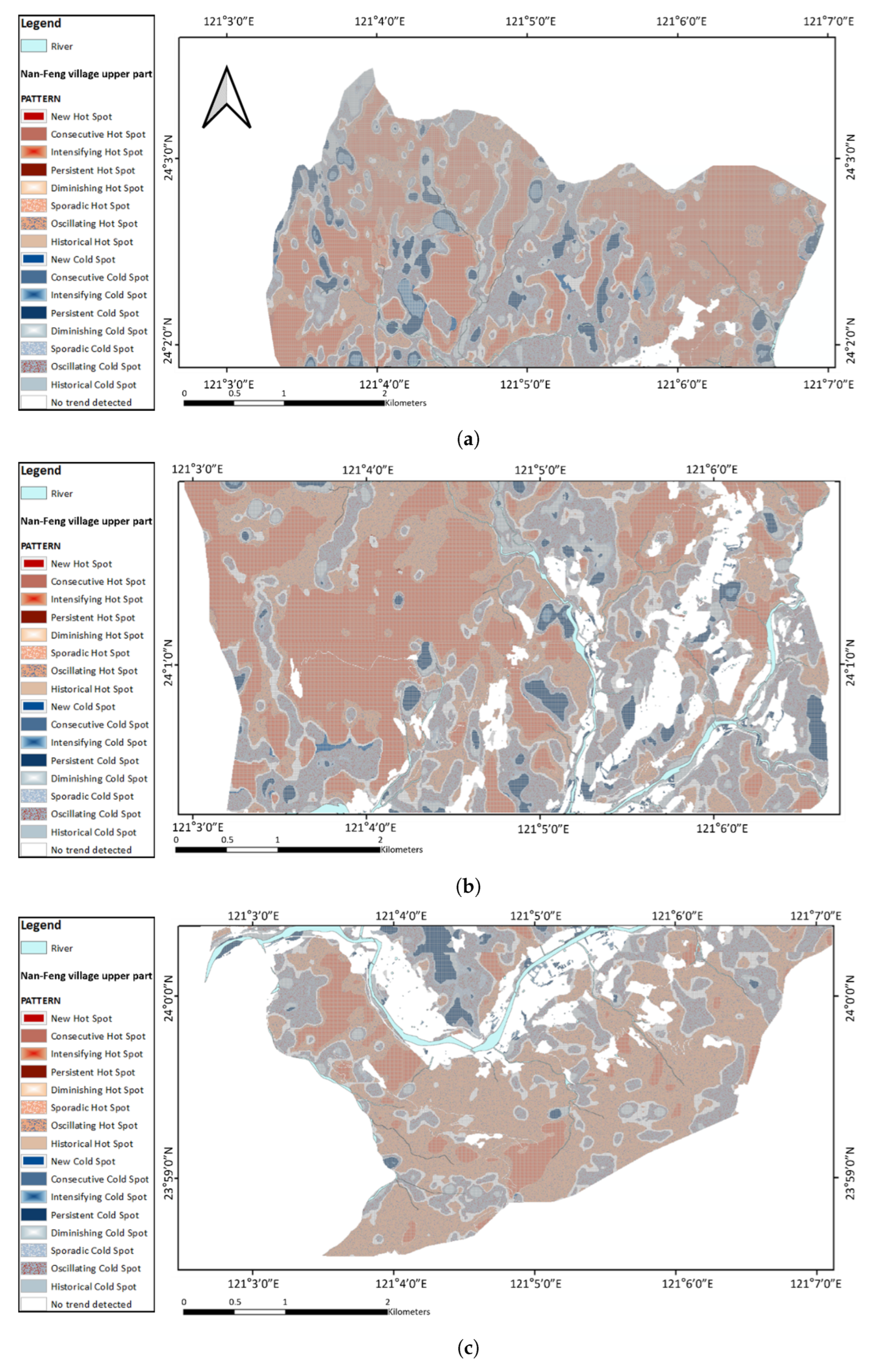
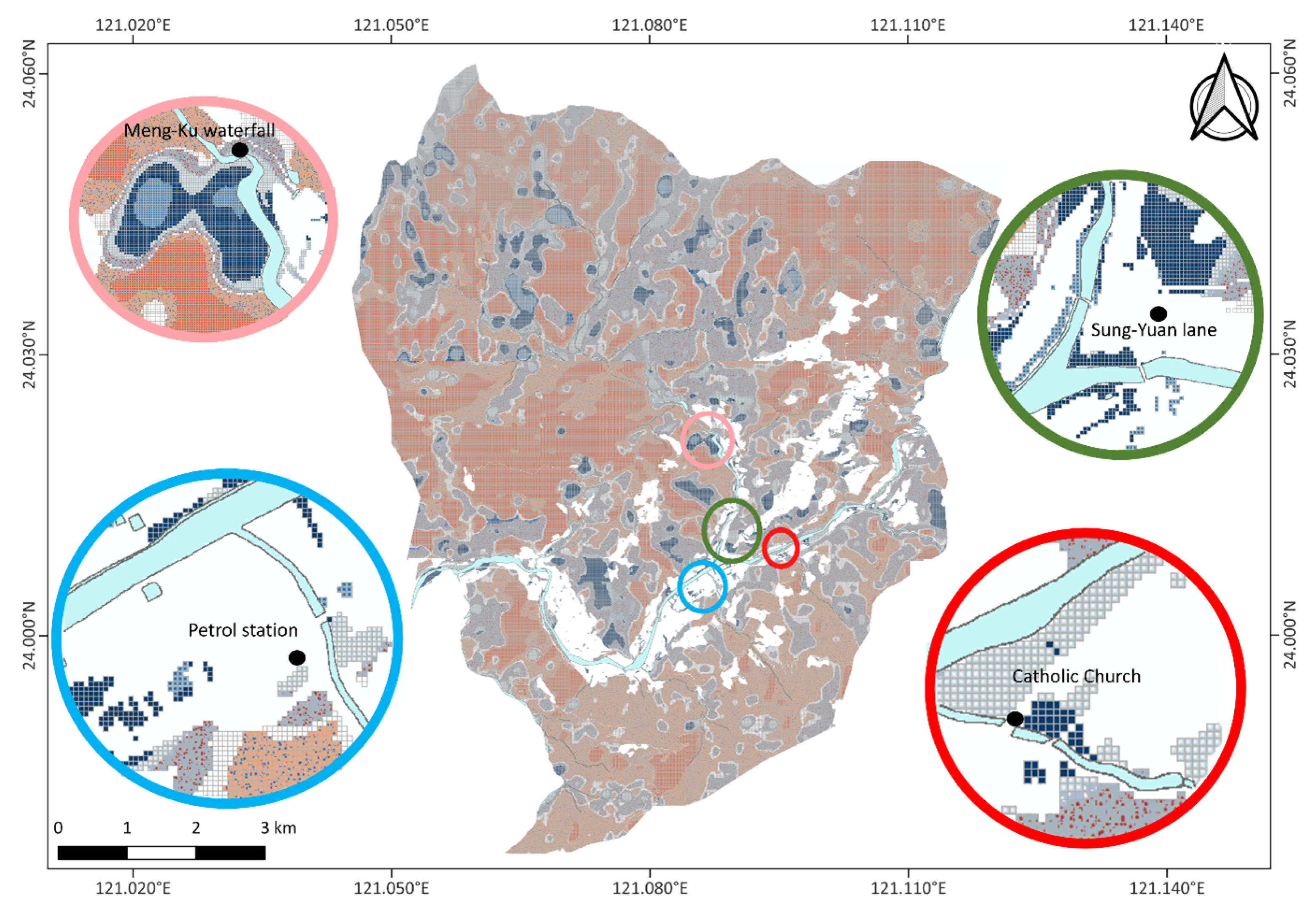
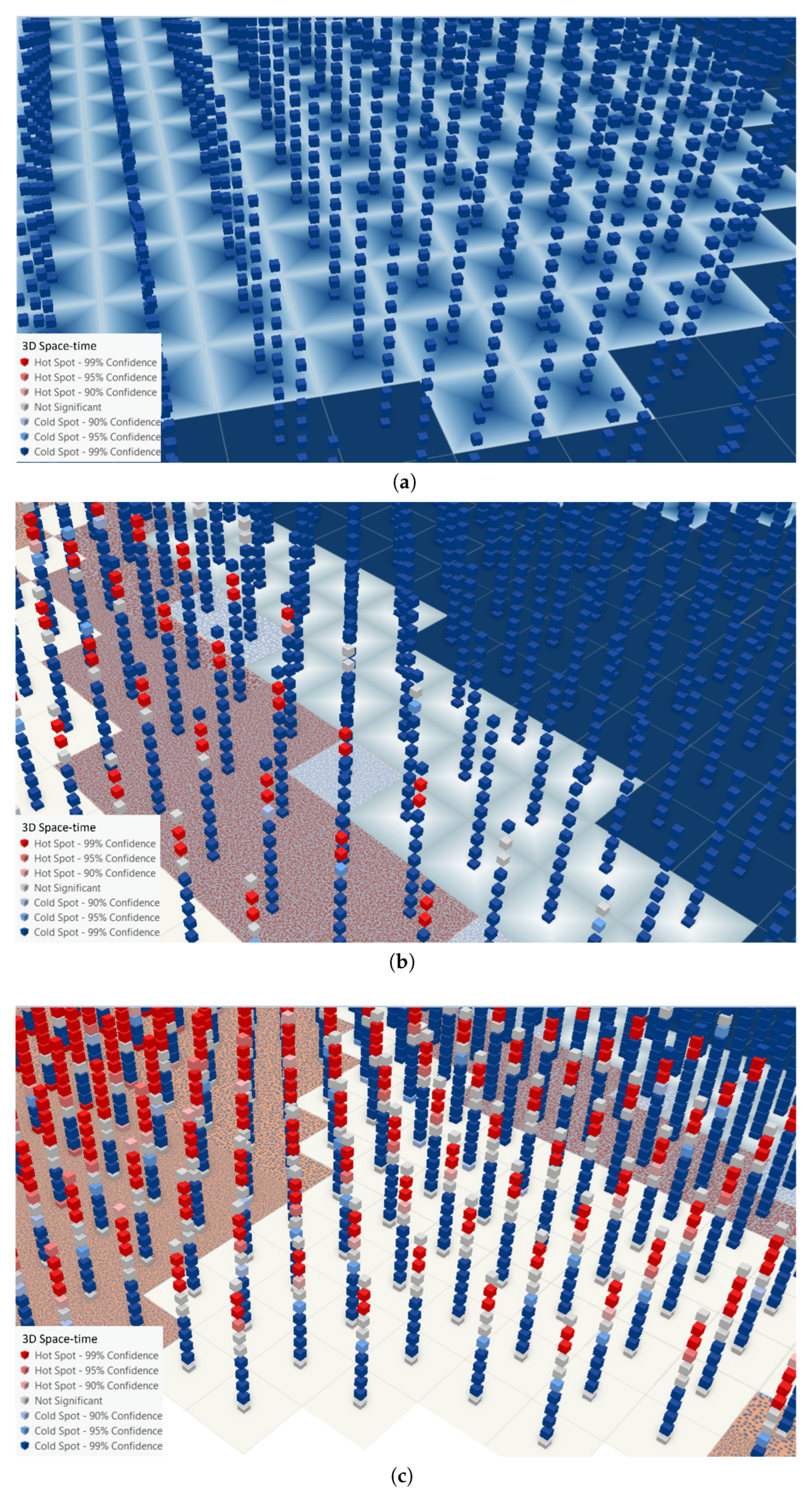
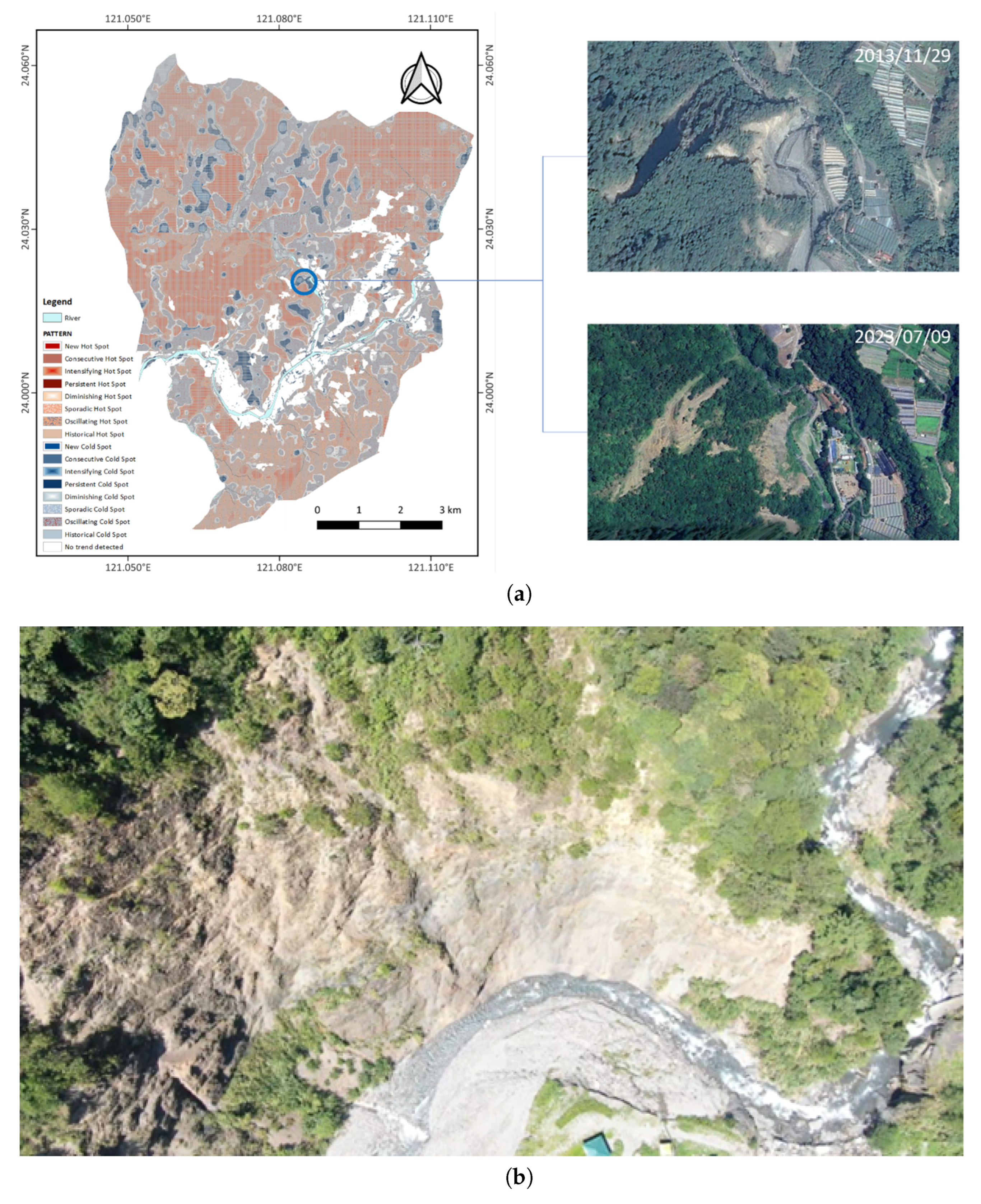
| Attribute | SPOT 6/7 | Pléiades-1A/1B |
|---|---|---|
| Resolution (MS/PAN) | 6 m/1.5 m | 2 m/0.5 m |
| Time | 2013–2023 | 2019–2023 |
| Images used | 66 images (used to create 11 annual NDVI composites) | 5 (Annual NDVI) |
| Main application | Long-term NDVI trends | Typhoon impact and short-term trends |
| Hot Spot Type | Description |
|---|---|
| New Hot Spot | Statistically significant hot spot in the final time step, with no prior hot spot history. |
| Consecutive Hot Spot | Statistically significant hot spot in the final and at least the previous time step, not a hot spot before these consecutive time steps, and in less than 90% of all time steps. |
| Intensifying Hot Spot | Hot spot in 90% or more of time steps, including the final one, with the intensity of clustering of high values significantly increasing. |
| Persistent Hot Spot | Hot spot in 90% or more of time steps, including the final one, with no significant trend in clustering intensity. |
| Diminishing Hot Spot | Hot spot in 90% or more of time steps, including the final one, with the intensity of clustering of high values significantly decreasing. |
| Sporadic Hot Spot | Hot spot in the final time step, hot spot in less than 90% of time steps, and never a cold spot. |
| Oscillating Hot Spot | Hot spot in the final time step, hot spot in less than 90% of time steps, and has also been a cold spot in the past. |
| Historical Hot Spot | Not a hot spot in the final time step but a hot spot in 90% or more of past time steps. |
| New Cold Spot | Statistically significant cold spot in the final time step, with no prior cold spot history. |
| Consecutive Cold Spot | Statistically significant cold spot in the final and at least the previous time step, not a cold spot before these consecutive time steps, and in less than 90% of all time steps. |
| Intensifying Cold Spot | Cold spot in 90% or more of time steps, including the final one, with the intensity of clustering of low values significantly increasing. |
| Persistent Cold Spot | Cold spot in 90% or more of time steps, including the final one, with no significant trend in clustering intensity. |
| Diminishing Cold Spot | Cold spot in 90% or more of time steps, including the final one, with the intensity of clustering of low values significantly decreasing. |
| Sporadic Cold Spot | Cold spot in the final time step, cold spot in less than 90% of time steps, and never a hot spot. |
| Oscillating Cold Spot | Cold spot in the final time step, cold spot in less than 90% of time steps, and has also been a hot spot in the past. |
| Historical Cold Spot | Not a cold spot in the final time step but a cold spot in 90% or more of past time steps. |
| No Pattern Detected | Does not fall into any hot spot or cold spot category. |
Disclaimer/Publisher’s Note: The statements, opinions and data contained in all publications are solely those of the individual author(s) and contributor(s) and not of MDPI and/or the editor(s). MDPI and/or the editor(s) disclaim responsibility for any injury to people or property resulting from any ideas, methods, instructions or products referred to in the content. |
© 2025 by the authors. Licensee MDPI, Basel, Switzerland. This article is an open access article distributed under the terms and conditions of the Creative Commons Attribution (CC BY) license (https://creativecommons.org/licenses/by/4.0/).
Share and Cite
Nguyen, K.A.; Jiang, Y.-J.; Chen, W. Identifying Slope Hazard Zones in Central Taiwan Using Emerging Hot Spot Analysis and NDVI. Sustainability 2025, 17, 7428. https://doi.org/10.3390/su17167428
Nguyen KA, Jiang Y-J, Chen W. Identifying Slope Hazard Zones in Central Taiwan Using Emerging Hot Spot Analysis and NDVI. Sustainability. 2025; 17(16):7428. https://doi.org/10.3390/su17167428
Chicago/Turabian StyleNguyen, Kieu Anh, Yi-Jia Jiang, and Walter Chen. 2025. "Identifying Slope Hazard Zones in Central Taiwan Using Emerging Hot Spot Analysis and NDVI" Sustainability 17, no. 16: 7428. https://doi.org/10.3390/su17167428
APA StyleNguyen, K. A., Jiang, Y.-J., & Chen, W. (2025). Identifying Slope Hazard Zones in Central Taiwan Using Emerging Hot Spot Analysis and NDVI. Sustainability, 17(16), 7428. https://doi.org/10.3390/su17167428









